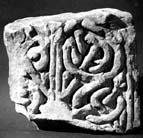Select a site alphabetically from the choices shown in the box below. Alternatively, browse sculptural examples using the Forward/Back buttons.
Chapters for this volume, along with copies of original in-text images, are available here.
Object type: Fragment of cross-shaft [1]
Measurements: H. 22.7 cm (9 in); W. 22.9 cm (9 in); D. 10.8 cm (4.25 in)
Stone type: Sandstone (pollution blackened), pale yellow-brown, medium to coarse-grained, hard quartz cemented, slightly micaceous. Middle Coal Measures Group, Carboniferous (Local Thornhill Rock?). [G.L.]
Plate numbers in printed volume: Ills. 212-4
Corpus volume reference: Vol 8 p. 139-40
(There may be more views or larger images available for this item. Click on the thumbnail image to view.)
This is part of a cross-shaft. All surviving faces are edged with a fine double roll moulding. The style of carving varies somewhat from face to face.
A (broad): On this face, the strands have straight sides but a modelled surface. The crossing strands cut through the underlying strands rather than flow over them, leaving short sausage-like sections. Nevertheless this is a clear attempt at a modelled style. The design features a bush-scroll with a double stem springing from a flat semi-circular root and dividing the panel vertically. The left-hand side is mostly missing, however. At the top a tendril springs from the central stem and forms a spiral volute with which is enlaced another twig which springs from near the root. A battered binding leads to another volute in the lower right corner, and this too enmeshes a tendril which springs from the side of the root. This tendril terminates in a tri-lobed leaf, or paired leaves with a bud, between the two volutes.
B (narrow): The modelling of the inner mouldings is very slight, especially on the right edge. The face itself is dressed plain.
C (broad): The face now hidden in the display has a second bush-scroll in a flat, un-modelled style which is actually more competent and regular than the attempt on face A. The central stem is a double incised line with a stepped base, which is centred on a semi-circular mound the width of the face. A tendril which divides into two volutes springs from the root on each side. Each volute terminates in a large flower, and pointed leaves fill the spandrels.
D (narrow): Missing
Collingwood (1915a, 171) compared the interlacing scrolls on face A, which stop short of the crossings without pretending to pass under or over, to the 'stopped-plait' with this characteristic on some Cumbrian sculpture such as those from St Bees (Bailey and Cramp 1988, 145–7, ills. 543–55). However, Bailey saw this piece as an example of an Anglian precursor to the Anglo- Scandinavian 'spiral-scroll school' exemplified by St Bees (ibid., 36), the influence of which is also seen in the West Riding, and this seems the most likely scenario in view of its relative competence. The floral terminations on the Dewsbury piece relate it to those on the cross-head from Little Ouseburn (no. 5, Ill. 535), and it may not be much later in date. It is in a recognisably modelled style, and the bush-scroll on face C is also paralleled on other Anglian-period sculptures, for example Ilkley 6 (Ill. 387).



